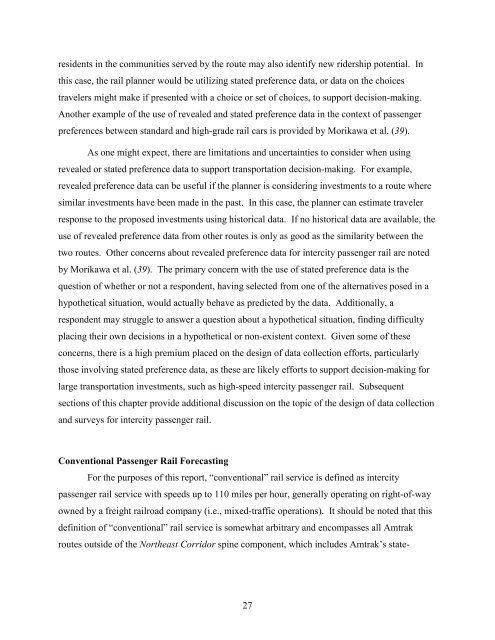Measuring the Benefits of Intercity Passenger Rail: A Study
Measuring the Benefits of Intercity Passenger Rail: A Study
Measuring the Benefits of Intercity Passenger Rail: A Study
You also want an ePaper? Increase the reach of your titles
YUMPU automatically turns print PDFs into web optimized ePapers that Google loves.
esidents in <strong>the</strong> communities served by <strong>the</strong> route may also identify new ridership potential. In<br />
this case, <strong>the</strong> rail planner would be utilizing stated preference data, or data on <strong>the</strong> choices<br />
travelers might make if presented with a choice or set <strong>of</strong> choices, to support decision-making.<br />
Ano<strong>the</strong>r example <strong>of</strong> <strong>the</strong> use <strong>of</strong> revealed and stated preference data in <strong>the</strong> context <strong>of</strong> passenger<br />
preferences between standard and high-grade rail cars is provided by Morikawa et al. (39).<br />
As one might expect, <strong>the</strong>re are limitations and uncertainties to consider when using<br />
revealed or stated preference data to support transportation decision-making. For example,<br />
revealed preference data can be useful if <strong>the</strong> planner is considering investments to a route where<br />
similar investments have been made in <strong>the</strong> past. In this case, <strong>the</strong> planner can estimate traveler<br />
response to <strong>the</strong> proposed investments using historical data. If no historical data are available, <strong>the</strong><br />
use <strong>of</strong> revealed preference data from o<strong>the</strong>r routes is only as good as <strong>the</strong> similarity between <strong>the</strong><br />
two routes. O<strong>the</strong>r concerns about revealed preference data for intercity passenger rail are noted<br />
by Morikawa et al. (39). The primary concern with <strong>the</strong> use <strong>of</strong> stated preference data is <strong>the</strong><br />
question <strong>of</strong> whe<strong>the</strong>r or not a respondent, having selected from one <strong>of</strong> <strong>the</strong> alternatives posed in a<br />
hypo<strong>the</strong>tical situation, would actually behave as predicted by <strong>the</strong> data. Additionally, a<br />
respondent may struggle to answer a question about a hypo<strong>the</strong>tical situation, finding difficulty<br />
placing <strong>the</strong>ir own decisions in a hypo<strong>the</strong>tical or non-existent context. Given some <strong>of</strong> <strong>the</strong>se<br />
concerns, <strong>the</strong>re is a high premium placed on <strong>the</strong> design <strong>of</strong> data collection efforts, particularly<br />
those involving stated preference data, as <strong>the</strong>se are likely efforts to support decision-making for<br />
large transportation investments, such as high-speed intercity passenger rail. Subsequent<br />
sections <strong>of</strong> this chapter provide additional discussion on <strong>the</strong> topic <strong>of</strong> <strong>the</strong> design <strong>of</strong> data collection<br />
and surveys for intercity passenger rail.<br />
Conventional <strong>Passenger</strong> <strong>Rail</strong> Forecasting<br />
For <strong>the</strong> purposes <strong>of</strong> this report, “conventional” rail service is defined as intercity<br />
passenger rail service with speeds up to 110 miles per hour, generally operating on right-<strong>of</strong>-way<br />
owned by a freight railroad company (i.e., mixed-traffic operations). It should be noted that this<br />
definition <strong>of</strong> “conventional” rail service is somewhat arbitrary and encompasses all Amtrak<br />
routes outside <strong>of</strong> <strong>the</strong> Nor<strong>the</strong>ast Corridor spine component, which includes Amtrak’s state-<br />
27
















